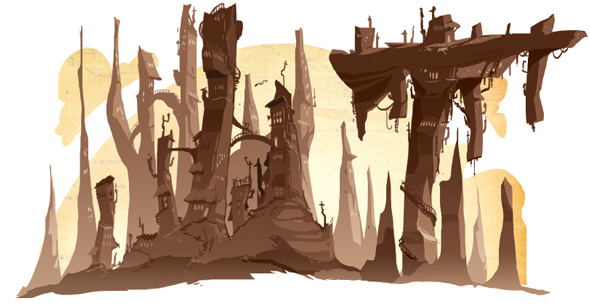
This week we’re diving into yet another important aspect of drawing: Backgrounds!
This article was inspired by Lorenzo Etherington’s fabulous instructions in our Illustrator’s Guidebook Vol.1 as well as Mark Kistler’s course Learn to Draw in 21 Days (Season 1).
Backgrounds are the foundation of any great composition. They provide essential information to enhance your scene, especially if you’re including characters. So, let’s dive into it!
Backgrounds shouldn’t be flat; they need depth to create a sense of immersion. Start by dividing your background into layers: foreground, middle ground, and background. Use different levels of detail and contrast to differentiate these layers. This technique adds visual interest and draws the viewer deeper into your art.

To add cohesion, unity, and balance to your background, try to limit your use of different shapes. Shapes can set the mood of your background, so choose carefully with your full composition in mind. Think about how different shapes would look. Circles? Squares? Ellipses? Tall shapes? Wide shapes? The possibilities are endless!

Ensure that elements in your background are proportionate to your main subjects. Avoid oversized or undersized objects unless it’s for deliberate artistic effect. Correct scale and proportion maintain the harmony and believability of your artwork, helping the viewer’s eye navigate through the composition effortlessly.

Lighting sets the mood and adds dimensionality to your background. Consider the position of your light source and how it interacts with objects in your scene. Use shadows creatively to define forms and create depth. Play with contrasts between light and shadow to create focal points and direct the viewer’s gaze.

Textures in backgrounds can add richness and tactile quality to your art. Experiment with different brush strokes, patterns, or even textured brushes to create varied surfaces such as wood, stone, foliage, or water. This not only enhances realism but also adds a sensory dimension to your artwork.

Backgrounds should tell a story and evoke emotion. Consider the setting and its relationship to your main subjects. Is it a bustling cityscape, a serene countryside, or a mysterious forest? Use colors, composition, and details to convey the desired mood and narrative, enriching the viewer’s experience.

Remember, continuous practice and observation are essential to mastering backgrounds. Study real-life environments, observe how light interacts with different surfaces, and practice incorporating these observations into your artwork. Experiment with different techniques and don’t be afraid to make mistakes—they’re essential for growth!
Need a refresher on one-point or two-point perspective for your backgrounds? Mark Kister’s got you covered in his course, along with many other tips and tricks.

Drawing compelling backgrounds is a skill that enhances your overall artistic ability, making your artwork more immersive and engaging. By employing techniques such as layering, perspective, texture, and storytelling, you can elevate your backgrounds from mere settings to integral parts of your artistic expression. Remember, every stroke and detail contributes to the narrative you wish to convey.
To help guide you in your background drawings, check out our great resources such as Lorenzo Etherington’s Background Chapter in the Illustrator’s Guidebook Vol.1, or, to cover the basics, head over to Mark Kistler’s course Learn to Draw in 21 Days (Season 1).
We hope these tips inspire and guide you on your artistic journey. Stay creative, keep exploring, and most importantly, enjoy the process of bringing your backgrounds to life!
Emilie Apel is a French/American multidisciplinary artist based in the U.S. She travels frequently to Nepal and loves exploring the fusion between her meditation practice and art. Emile's favorite medium is watercolors.